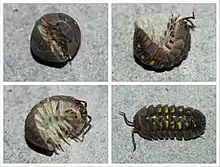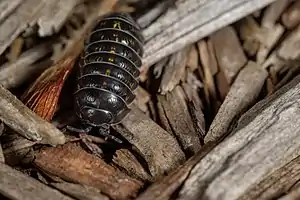Armadillidiidae
Armadillidiidae is a family of woodlice, a terrestrial crustacean group in the order Isopoda. Unlike members of some other woodlice families, members of this family can roll into a ball, an ability they share with the outwardly similar but unrelated pill millipedes and other animals. This ability gives woodlice in this family their common names of pill bugs[1] or roly polies.[2] Other common names include slaters, potato bugs, butchy boys[3] and doodle bugs.[4] Most species are native to the Mediterranean Basin, while a few species have wider European distributions. The best-known species, Armadillidium vulgare, was introduced to New England in the early 19th century and has become widespread throughout North America.[5]
| Armadillidiidae Temporal range: Chattian-recent | |
|---|---|
 | |
| An Armadillidium granulatum in various stages of conglobulation, i.e., "rolling up" | |
| Scientific classification | |
| Domain: | Eukaryota |
| Kingdom: | Animalia |
| Phylum: | Arthropoda |
| Class: | Malacostraca |
| Superorder: | Peracarida |
| Order: | Isopoda |
| Suborder: | Oniscidea |
| Section: | Crinocheta |
| Family: | Armadillidiidae Brandt, 1833 |
| Genera | |
|
See text | |
Common names
| Name | Region |
|---|---|
| Pill bug | Global |
| Rollie Pollie, Roly Poly | USA (Texas) |
| Woodlice | UK, Australia |
| Slater Bugs | Australia |
| Cheesy bug | UK (parts of) |
| Sowbug | USA |
| Doodlebug | USA (southern regions) |
| Slater | Australia, New Zealand, Scotland (North-East), Ireland (Ulster) |
| Butcher boy | Australia |
| Cellar Bugs | Germany |
| Carpenter | USA (certain regions) |
| bed pisser Pissebed | Netherlands / Belgium |
| Door closer Cloporte | Francophone regions |
| Parsons Pig | UK |
| Bench biters | Denmark |
| Chiggy pig | UK (Devon) |
| Chuckie pig | USA (South) |
| Little pig Chanchito | South America (certain countries) |
| Potato bug | UK |
| Gramersow | UK (Cornwall) |
Ecology and behavior
Pill bugs in the family Armadillidiidae are able to form their bodies into a ball shape, in a process known as conglobation. Conglobation has evolved independently in several families, this behaviour is shared with pill millipedes (which are often confused with pill bugs),[6] armadillos, and cuckoo wasps.[7] It may be triggered by stimuli such as vibrations or pressure, and is a key defense against predation; it may also reduce respiratory water losses.[8] This defense mechanism is possible because of their segmented body structure. Armadillidiidae have overlapping plates called tergites that are connected by flexible joints. The tergites allow the body to roll up inwards. To roll up, they have muscles called pleopods that contract the abdominal tergites inwards.
The diet of pill bugs is largely made up of decaying or decomposed plant matter such as leaves, and to a lesser extent, wood fibers. Pill bugs will also eat living plants, especially in wet conditions, sometimes consuming leaves, stems, shoots, roots, tubers, and fruits. Some species of pill bugs are known to eat decaying animal flesh or feces.[9] They will also eat shed snakeskin and dead bugs, if necessary. This diet has a secondary effect of decelerating the breakdown of litter, aiding in the retention of organic material in the soil. This helps in balancing the carbon content in the soil. Pill bugs also contribute to their ecosystem as decomposers.
However, pill bugs can be serious pests in certain agricultural systems, particularly in areas that are prone to heavy rains and flood conditions. Since they are attracted to decaying plant matter, they are often found on farms eating the crop residue. This leads pill bugs to start eating emerging seedlings. This has started to pose huge agricultural problems in Southern Australia. Farmers in the United States and in Argentina have also reported increased rates of pill bugs destroying seed oil and soybean crops. They have also been observed eating wood supports in houses making them a house pest. Pill bugs will feed on numerous crop plants including corn, beans, squash, peas, melon, chard, beet, cucumber, potato, spinach, lettuce, and strawberry, with potential for significant yield loss in strawberry in particular.

Classification
The family Armadillidiidae is differentiated from other woodlouse families by the two-segmented nature of the antennal flagellum, by the form of the uropods, and by the ability to roll into a ball.[10]
Within the family Armadillidiidae, 15 genera are currently recognized:[11]
- Alloschizidium Verhoeff, 1919 (13 species)
- Armadillidium Brandt, 1831 (189 species)
- Ballodillium Vandel, 1961 (monotypic)
- Cristarmadillidium Arcangeli, 1936 (4 species)
- Cyphodillidium Verhoeff, 1939 (monotypic)
- Echinarmadillidium Verhoeff, 1901 (3 species)
- Eleoniscus Racovitza, 1907 (monotypic)
- Eluma Budde-Lund, 1885 (3 species)
- Paraschizidium Verhoeff, 1919 (5 species)
- Paxodillidium Schmalfuss, 1985 (monotypic)
- Platanosphaera Strouhal, 1956 (6 species)
- Schizidium Verhoeff, 1901 (26 species)
- Trichodillidium Schmalfuss, 1989 (3 species)
- Troglarmadillidium Verhoeff, 1900 (8 species)
- Trogleluma Vandel, 1946 (2 species)
- Typhlarmadillidium Verhoeff, 1900 (4 species)
A 2022 study of myrmecophilous populations indicated that these represented a new species of Cristarmadillidium, and three new species within a new genus, Iberiarmadillidium.[12]
References
- Gordon Gordh & David H. Headrick (2011). "Common pillbug". A Dictionary of Entomology (2nd ed.). CAB International. p. 343. ISBN 9781845935429.
- Franklin, J. A., Byron, M. A., & Gillett-Kaufman, J. L. (2015, August). Armadillidium vulgare. Pillbug - Armadillidium vulgare. Retrieved September 7, 2022, from https://entnemdept.ufl.edu/creatures/MISC/Armadillidium_vulgare.htm
- Erica (2013-04-11). "Roly-Poly Slaters". Gardening 4 Kids. Retrieved 2023-04-17.
- Kenn Kaufman & Kimberly Kaufman (2012). Kaufman Field Guide to Nature of New England. Houghton Mifflin Harcourt. p. 364. ISBN 9780618456970.
- Spyros Sfenthourakis & Hornung Elisabeth (2018). "Isopod Distribution and Climate Change". ZooKeys (801): 25–61. doi:10.3897/zookeys.801.23533. PMC 6288265. PMID 30564031.
- "Pill millipede (Glomeris marginata)". ARKive. Archived from the original on 2006-06-17. Retrieved June 21, 2007.
- Edward M. Barr (2001). Animal behavior desk reference: a dictionary of animal behavior, ecology, and evolution (2nd ed.). CRC Press. p. 142. ISBN 978-0-8493-2005-7.
- Jacob T. Smigel & Allen G. Gibbs (2008). "Conglobation in the pill bug, Armadillidium vulgare, as a water conservation mechanism". Journal of Insect Science. 8 (44): 1–9. doi:10.1673/031.008.4401. PMC 3127403. PMID 20233103.
- "What Do Pill Bugs Eat?". Orkin.com. Retrieved 8 May 2018.
- P. J. Hayward & John Stanley Ryland (1995). "Crustaceans". Handbook of the marine fauna of north-west Europe. Oxford University Press. pp. 289–461. ISBN 978-0-19-854055-7.
- Marilyn Schotte (2012). Schotte M, Boyko CB, Bruce NL, Poore GC, Taiti S, Wilson GD (eds.). "Armadillidiidae". World Marine, Freshwater and Terrestrial Isopod Crustaceans database. World Register of Marine Species. Retrieved September 26, 2012.
- Recuero, Ernesto; Rodríguez-Flores, Paula C.; García-París, Mario (2022). "Homoplasy and morphological stasis revealed through multilocus phylogeny of new myrmecophilous species in Armadillidiidae (Isopoda: Oniscidea)". Zoological Journal of the Linnean Society. 194 (4): 1312–1340. doi:10.1093/zoolinnean/zlab066.
External links
 Media related to Armadillidiidae at Wikimedia Commons
Media related to Armadillidiidae at Wikimedia Commons Data related to Armadillidiidae at Wikispecies
Data related to Armadillidiidae at Wikispecies- Regional maps for the most common American names for this isopod can be found in the results for question 74 of the Harvard Dialect Survey Archived 2012-01-10 at the Wayback Machine